IB SL Physics all units
1/277
There's no tags or description
Looks like no tags are added yet.
Name | Mastery | Learn | Test | Matching | Spaced |
|---|
No study sessions yet.
278 Terms
making degrees smaller
1º = 60’ (minutes of arc)
1’ = 60’’ (seconds of arc)
1º = 3600’’
parallax
the apparent shift of a near star compared to the distant stars over a period of time
a star will look like it has moved backwards and forwards throughout the year
really it is Earth that has moved which changes the perspective from which we look
other stars will look like they haven’t moved because they are so far away
angle of parallax and finding it
angle of parallax is measured in seconds of arc, when it is 1’ the distance is one parsec
further away = smaller angle of parallax
distance between earth’s position in June and in December is 2R, p = parallax angle
the distance to the star is Tanp = R/d therefore d=R/tanp
using small angle approximation:
tanp = p therefore d=R/p (when the angle is measured in radians)
finding distance in parsecs
when these distances are too approximate
d(parsec) = 1/p (arc-second)
angles smaller the 1/100 arc seconds are too small to measure accurately so distances farther away than about 100 parsecs are too approximate to be useful
luminosity
stars are assumed to radiate like black bodies (emissivity =1), equation is P=eσAT^4
luminosity = power of a star
L=σAT^4
power
efficiency
σ — constant
area — can be written as area of a circle (stars are spheres but we see circles)
L=σπR^2T^4
temperature
combining brightness and luminosity equations
surface are of a sphere = 4πR^2
brightness is the power per unit area received at a distance from the source
b=L/4πR^2
luminosity cannot be directly measured but it can be calculated from brightness and distance found using parallax
combining the two formulae (not in data booklet)
b=σAT^4/4πd^2
d = distance from us to star
stellar spectra and Wien’s law
stellar spectra — below 400nm = ultraviolet radiation at a hotter temperature
Wien’s law — λmaxT = 2.9x10^-3 mK
because the product is a constant λ and T are inversely proportional
the smaller the maximum wavelength, the greater the temperature
classifying stars based on temperature
stars are separated into classes based on their temperature
hot to cold = O, B, A, F, G, K, M
our sun is class G
the hottest stars are blue and the coldest are red
Hertzsprung-Russell (HR) diagram
stars age following the main sequence from top left to bottom right
temperature is measured from highest to lowest — pay attention to the axes
L star/L☉ is used for the y axis, ☉ represents the sun, ratio of Lstar to L☉
y axis is exponential
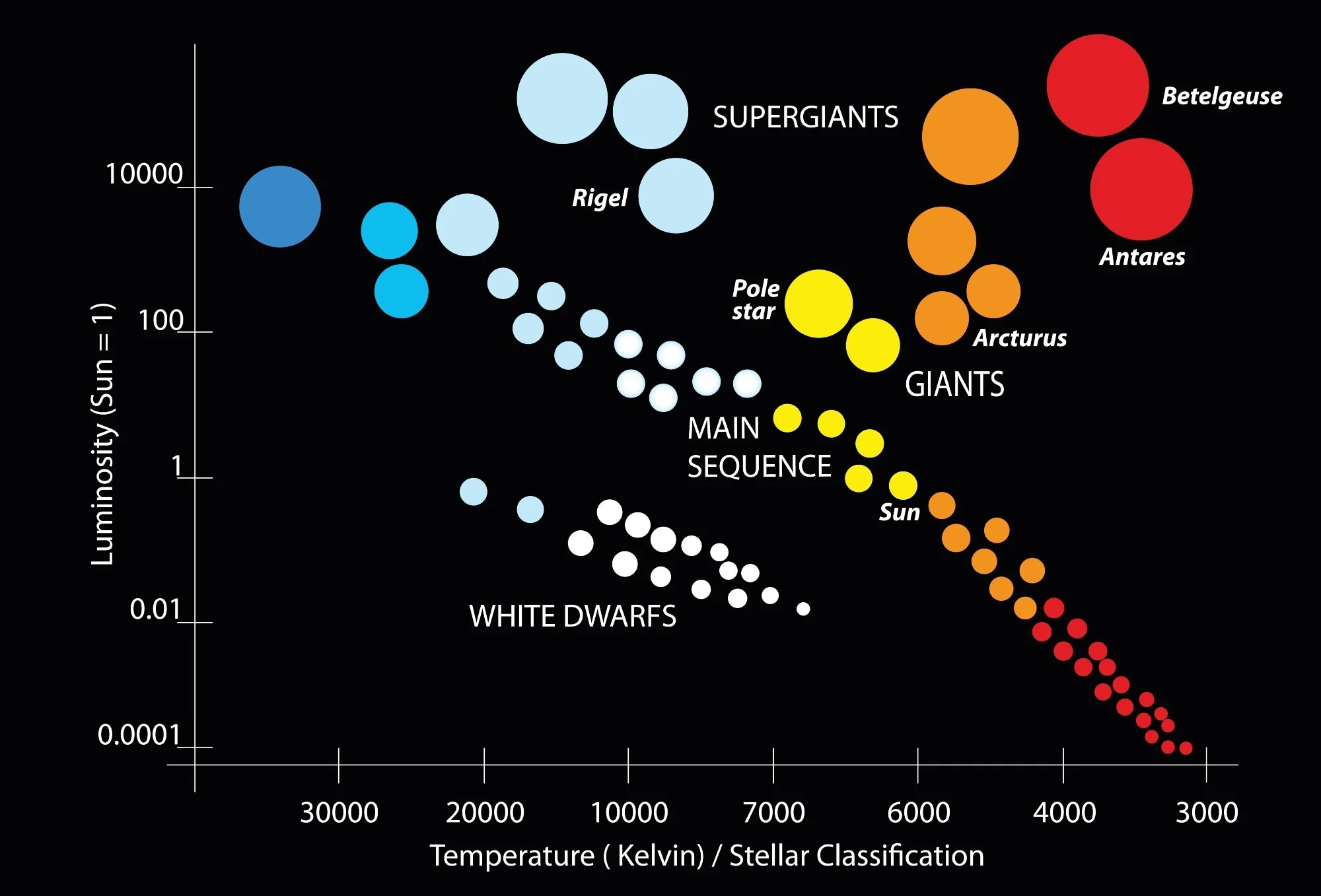
brightness and luminosity of the super giants, relative to the sun
why there aren’t super giants in the bottom left of the HR diagram
super giants have to be incredibly big to be brighter than the sun given the equations for brightness and luminosity
no super giants in the bottom left corner because the temperature is too high (relative to the luminosity), we don’t see objects of that temperature in the universe
linking luminosity and mass for main sequence stars
for stars in the main sequence the luminosity and mass (M) of the star can be linked
L=σAT^4
A=4πR^2
L∝R^2
L∝M^3.5
3.5 comes from the exponent for the main sequence gradient
the gradient is not negative because the x axis goes from high to low
impact of a difference in mass on luminosity
a slight difference in the mass causes a huge difference in luminosity
a star with a mass 10 times that of the sun will have a luminosity of 10^3.5 times the luminosity of the sun which is about 3200
stars have different densities
more luminous stars on the main sequence have greater mass and shorter lives than less luminous stars on the main sequence
single star
A luminous sphere of plasma held together by its own gravity.
binary star
two stars orbiting a common centre
black hole
A singularity in space-time.
cepheid variable
A star with a period of varying luminosity. The luminosity can be determined from the period and along with the apparent brightness can be used to determine the distance of the star from Earth.
cluster of galaxies
Two or more galaxies that are close enough to each other to affect each other through gravitation.
constellation
A pattern of stars visible from Earth that are not gravitationally bounded.
dark matter
Matter in galaxies that are too cold to radiate. Its existence is inferred from theoretical physics rather than direct visual contact.
galaxies
stars, gas, and dust held together by gravitational forces.
main sequence star
A normal star that is undergoing nuclear fusion of hydrogen into helium.
neutron stars
A very dense star, consisting only of uncharged neutrons
nebula
A cloud of dust, hydrogen, helium and other ionized gases.
planet
A celestial body that orbits a star.
planetary system
Gravitationally bounded non-stellar objects in orbit around a star or star system.
planetary nebula
The ejected envelope of a red giant star.
stellar clusters
A group of stars gravitationally bounded together.
the stability of a star
depends on the equilibrium of opposing forces
forces = gravitational, gas and radiation pressure
equilibrium gained through nuclear fusion which keeps the star hot
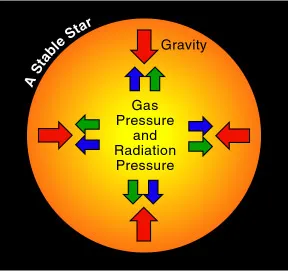
cepheid variables graphed
apparent magnitude of luminosity vs time
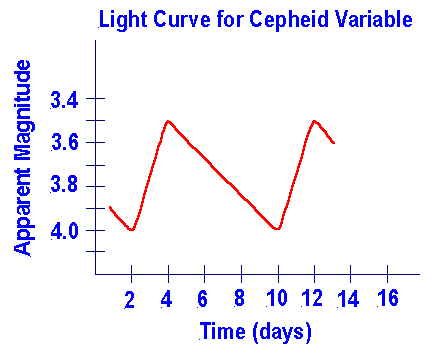
stellar evolution for less than 1.4 solar masses (solar mass of the sun = 1)
star stops fusing at about oxygen as the amount of energy released decreases
planetary nebula occurs (big explosion)
outer layers of the star blow away (gravity does not keep them together)
the core (leftover) becomes colder and colder, it contracts more and more (gravity)
electrons behave as a gas in the core and the pressure they generate stops the core from contracting
it becomes a white dwarf, cools and becomes invisible
Chandrasekhar limit
The largest mass a white dwarf can have is about 1.4 solar masses.
electron degeneracy prevents further collapse of the core provided that its mass is less than about 1.4 solar masses
the star will become a stable white dwarf then a black dwarf
dwarf = no fusion = dead star
Oppenheimer-Volkoff limit
the largest mass a neutron star can have is approximately 2-3 solar masses
when the mass of the star is 1.4-2.5 solar masses it is a neutron star
the core will collapse further (due to weight) until electrons are driven into protons forming neutrons
neutron pressure prevents the star from collapsing further which makes it a neutron star
neutron stars are heavy because there is no electromagnetic repulsion
when the Oppenheimer-Volkoff limit is exceeded the star becomes a black hole
Hubble’s law
describes the speed at which celestial bodies move away from each other at the present time and changes because the expansion of the universe if accelerating.
v=Hd
v = velocity
H = Hubble parameter
d = distance
using Hubble’s law to find the age of the universe
using the relationship between speed, distance and time
the age of the universe is the inverse of the Hubble constant
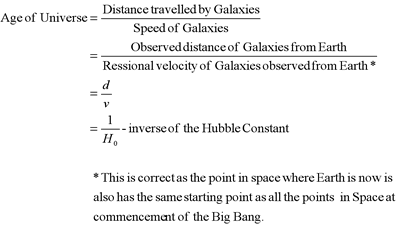
the cosmic scale factor (R)
a function of time which represents the relative expansion of the universe.
This may be represented by
![]()
where d(t) is the proper distance at time t, d0 is the distance at time t0, and a(t) is the cosmic scale factor.
Astrophysicists would out the cosmic scale factor using Einstein’s theory of general relativity laws.
Doppler effect in galaxies
light has a longer wavelength than when it was originally emitted
red shift (z) = unitless measure of the speed of an object as a proportion of the speed of light
change in wavelength due to velocity
galaxies rotate so light is doppler shifted
the radiation from the side approaching the earth is blue shifted and the radiation moving away from the earth is red shifted
velocity of recession
Hubble constant
velocity of recession = Hubble constant x distance
Hubble constant has units of k ms^-1 Mpc^-1
V=H₀d
z=H₀d/c
d=cz/H₀
uniform circular motion
circular motion at a constant speed
changing angular velocity and angular acceleration
acceleration is always directed toward the centre of the circular path
period is the time taken to complete one circle
centripetal force
causes the centripetal acceleration
towards the centre of the circle
F=Mv²/r
does no work, is a net force
centripetal acceleration
gives rise to circular motion
directed toward the centre of the circle
perpendicular to instantaneous velocity
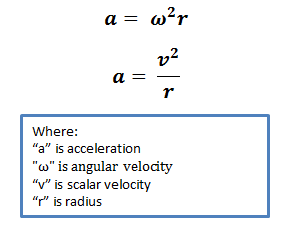
gravitational field strength
g=F/m
9.81ms^-2 on earth
oscillations
any vibration that goes back and forth without an overall resultant displacement
describing oscillations — displacement (x)
the distance the particle has moved from its rest position (equilibrium)
describing oscillations — amplitude (A)
the maximum distance that a particle moves from its rest position (this is a scalar!)
describing oscillations — frequency (f)
the number of oscillations per second or the number of waves to pass a point every second (also a scalar because of time), f=1/T
describing oscillations — period (T)
the time it takes for an oscillating particle to complete an oscillation or the time for a wave to move through one complete wavelength
graphing oscillations
on a sine wave, movement would continue infinitely without friction
sine waves come from circular motion looking at vertical or horizontal displacement from a point on the circumference of the circle
time on the x axis, displacement on the y axis
the length between repeating parts of the sine wave is the time period, direction matters in this eg. from halfway going up the time period would need to be measured until it hits the line going up again (not the first point where it would be going in the other direction)
amplitude on the wave is symmetrical on the horizontal access and the space between the extremes and the x axis
relating displacement, velocity and acceleration in SHM
velocity is the derivative of displacement
acceleration is the derivative of velocity, the derivative of the derivative of displacement
displacement cannot be represented as a derivative but it is the anti derivative of velocity (the integral)
displacement lags T/4 behind velocity, 3T/4 ahead (out of phase by…)
velocity lags T/4 behind acceleration, 3T/4 ahead
displacement lags T/2 behind acceleration (can go either way as it is in the middle)
conditions for SHM
There is a fixed cyclical path.
There is a central equilibrium point.
The motion repeats at equal time periods (periodic).
Displacement, velocity, and acceleration change continuously.
There is a restoring force directed toward the equilibrium point.
definition of SHM
motion arising from acceleration of an object that is proportional to its displacement from a fixed equilibrium point (rest position) and directed toward that point.
motion arising from a linear restoring force directed to a fixed equilibrium point
when is there a phase shift? what does it mean?
Two sinusoidal curves of equal period have a phase shift that translates one curve relative to the other in time, expressed as a fraction of a cycle, or as an angle in radians or degrees
travelling wave
a disturbance that propagates (transmits) energy without transferring physical material (a medium)
mechanical wave
A mechanical wave propagates its disturbance through a medium by an oscillating movement of the particles in the medium
transverse wave
particles of the medium oscillate perpendicular to the direction of the wave and propagation of energy.

longitudinal wave
the particles of the medium oscillate parallel to the direction of the wave, the wave and oscillations follow the same direction

electromagnetic wave
propagates as a transverse wave through a medium or a vacuum by oscillations of coupled, time-varying electric and magnetic fields
how is wave length measured?
wavelength (λ) is measured in metres as is amplitude (A)
wavelength is peak to peak while amplitude is vertical from the x axis to the peak
definition of a ray
the line showing the direction in which a wave transfers energy
direction of propagation, the two are parallel
perpendicular to the wave front
definition of a wave front
the surface that travels with a wave and is perpendicular to the direction in which the wave travels (the ray)
the lines that are perpendicular to the ray
parallel to the direction of propagation
wave fronts and rays from a point sources
this diagram shows a point source so makes waves that propagate away from the point, making the wave fronts circles
the rays are parallel to the tangent of the circle — if you zoomed in enough the curve would look flat
the rays can be perpendicular to the wave front as the tangent will always be a straight line
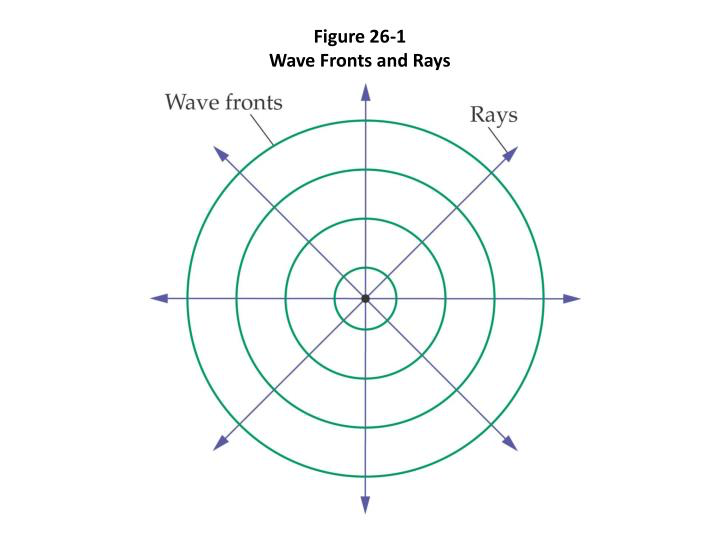
superposition
the resultant displacement at any point is the sum of the seperate displacements due to the two waves
the way we add waves, like dealing with vectors
constructive interference
constructive interference is when the waves are in phase so the amplitudes add together to produce a stronger signal
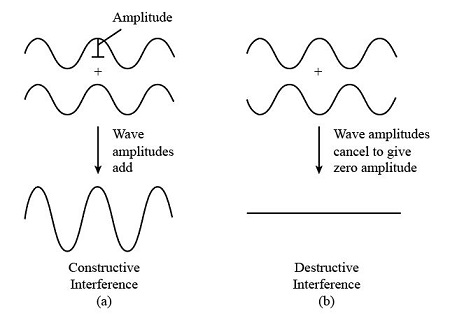
destructive interference
destructive interference is when the waves are out of phase so the amplitudes cancel each other out
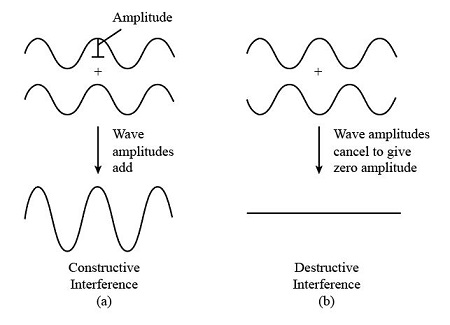
conditions for interference
only the amplitude can change if the waves have the same frequency, speed and wave length
the waves only cancel out completely is the amplitudes are the same
when two pulses meet they instantaneously become one and then continue as before having crossed over, this behaviour is different to particle collisions as the pulses do not join or rebound
intensity
intensity — the rate of energy transmitted (power) per unit area at right angles to the wave velocity
is proportional to the amplitude squared so doubling the amplitude will quadruple the intensity
measured in watts per square metre (Wm^-2)
energy is also proportional to the amplitude squared
polarisation of light
a polarised lens contains many long chains of molecules
after going through a polariser the amplitude of oscillations is diminished
critical angle
the smallest angle at which there is total internal reflection, the refractive angle is 90º
optical density
high to low optical density = away from the normal
low to high optical density = towards the normal
optical density has nothing to do with actual density, instead it is related to the refractive index
the refractive index of water is about 1.33
hot air and cold air have different refractive indexes
sine of a critical engle
the sine of the critical angle is n2/n1 so long as n2<n1 since the sine of any angle must be between -1 and 1
condition for total internal reflection
if the incident angle is greater than the critical angle there is total internal reflection such that the light goes like a mirror on the normal
how pulses collide
principle of superposition applies
when they overlap they add together
once they pass through each other they continue as if nothing happened
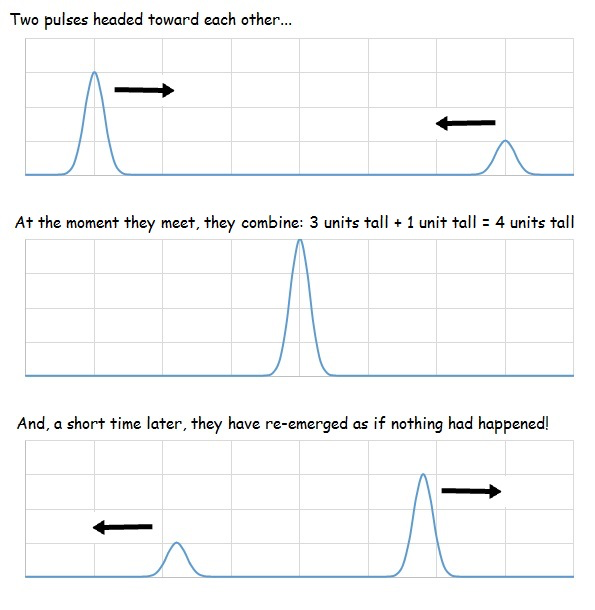
wave interference
waves of different frequencies can be added
any waves that are the same type (eg. both sound) can be added
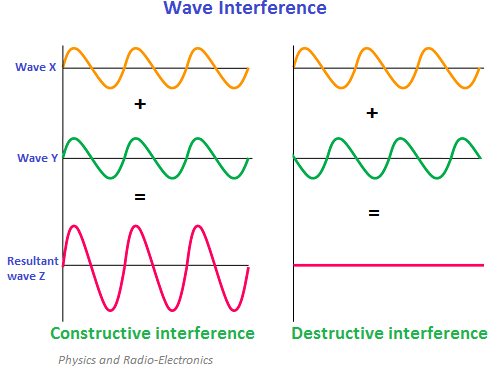
phase of waves
sine waves can be shown using a reference circle so can be referred to as an angle, this is the phase
completely out of phase (anti-phase)
the phase difference between the crests and valleys is pi which is referred to as completely out of phase
if waves that are completely out of phase meet the resultant displacement is zero
on a circle this is two points that are opposite each other showing the diameter of the circle
a phase difference of pi is also the distance of wave length/2
path difference leading to interference
a whole number path difference results in a phase difference of 0º so constructive interference occurs
if the path difference is half a wave length away from being a whole number (eg. 121/2(λ)) the phase difference is pi so destructive interference occurs
coherent waves
coherent waves have a constant phase difference which can be anything so long as its constant
coherent waves also have the same frequency however not all waves with the same frequency will be coherent
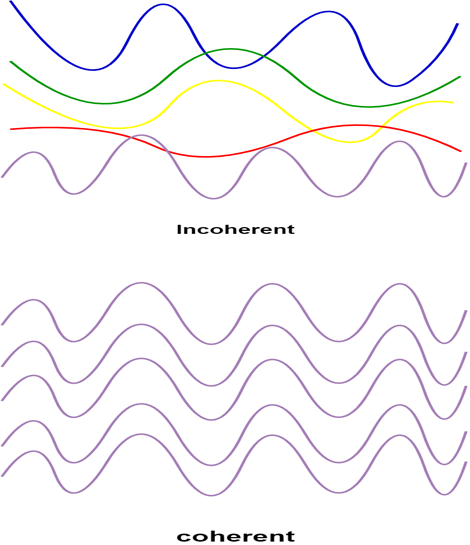
interference with coherent waves
two coherent sources of light will produce interference
when the path difference is an integer number of wave lengths (whole number) the interference will be constructive
destructive interference of coherent waves
a path difference of half a wave length will create maximum destructive interference
Huygen’s principle
Huygen’s principle — every point in a wave front is a point source of the wave
point source — a place in space which is an origin of waves
wave length definition
the distance between the wavefronts is the wavelength
the wavefronts are put at the peaks of the wave
the troughs are half way between the wavefronts assuming the waves are in SHM (are sinusoidal)
what is the energy in a wave proportional to?
the energy in a wave is proportional to the square of the wave’s amplitude
is the rate of energy transfer by waves constant?
straight waves in a uniform medium do not change wavelength or speed or direction or shape so the rate of energy transfer is also constant
for circular waves the amount of energy is constant along the wavefronts however it is distributed evenly so for the circumference of the wave front there is less energy the further from the point source it is measured, this is why amplitude decreases with distance for a circular wave
which waves can be polarised?
transverse waves
how is light polarised?
by going through a polariser
with an analyser perpendicular to the polariser no light is observed at the end
light must pass through thin molecular chains
reflecting light from a smooth surface
all light reflected from a smooth non-metallic surface is partially polarised
at a particular angle of incident (Brewster’s angle) on smooth insulators the light will be fully polarised
this is how polarising sunglasses work
Malus’ law
the relationship between intensity and the incident angle is not linear — the intensity of the unpolarised light entering the polariser must be twice the intensity of the polarised light leaving the polariser
small angle approximation (in radians!)
sinθ=0
cosθ=1
tanθ=0
standing wave definition
A standing wave (or stationary wave) is a wave in a medium in which each point on the wave axis has an associated constant amplitude – all points move coherently – and there is no transport of energy.
nodes on standing waves
The locations of zero amplitude are called nodes, and the locations of maximum amplitude are called anti-nodes. Adjacent nodes are separated by λ/2, where λ is the wavelength.
resonance
the situation in which an external driver oscillating at a system's natural frequency transfers energy into the system, which in this case is the standing wave.
electric charge (q)
current (I) x time (t)
measured in Coulombs (C)
1 Coulomb is the amount of charge carried by 1 Ampere in 1 second (derived unit)
current
measured in amperes, fundamental unit
potential difference (V)
work per unit charge, V=W/q
measured in Volts (V)
1 Volt is 1 Joule of work done on or by 1 Coulomb of charge
Coulomb’s law
The forces on two charges are equal in magnitude and opposite in direction
F ∝q1q2 → also F∝q1 and F∝q2
F∝r^-2 → F∝q1q2/r²
constant → F=k q1q2/r²
k = 1/4πε0 = permittivity of free space
the elementary charge (e)
every electron and proton has a charge of the same magnitude → 1.6×10^-19 C
positive for protons, negative for electrons
drawing electric field lines
lines don’t cross
begin on positive charges, end on negative charges
direction of the field is the direction of the force on a positive charge
more lines = stronger field
perpendicular to the surface of conductors
no field inside a conductor
uniform electric field
same strength and direction throughout the field
parallel plates and even distance between field lines
electric fields = vectors
electric field strength
the force per unit charge exerted on a stationary positive charge at a point
E=Fe/q so measured in NC^-1
volts
work done per unit charge
JC^-1
show that 1 NC^-1 = 1 Vm^-1
N/C = kg m /C s2 (as F=ma)
1 Volt = 1 J/C (as V=W/q)
1N/C = 1V/m = kg m /C s2
behaviour of a charge in a uniform electric field
mathematically same equations for Fg and Fe so charge is also subject to projectile motion following a parabolic path